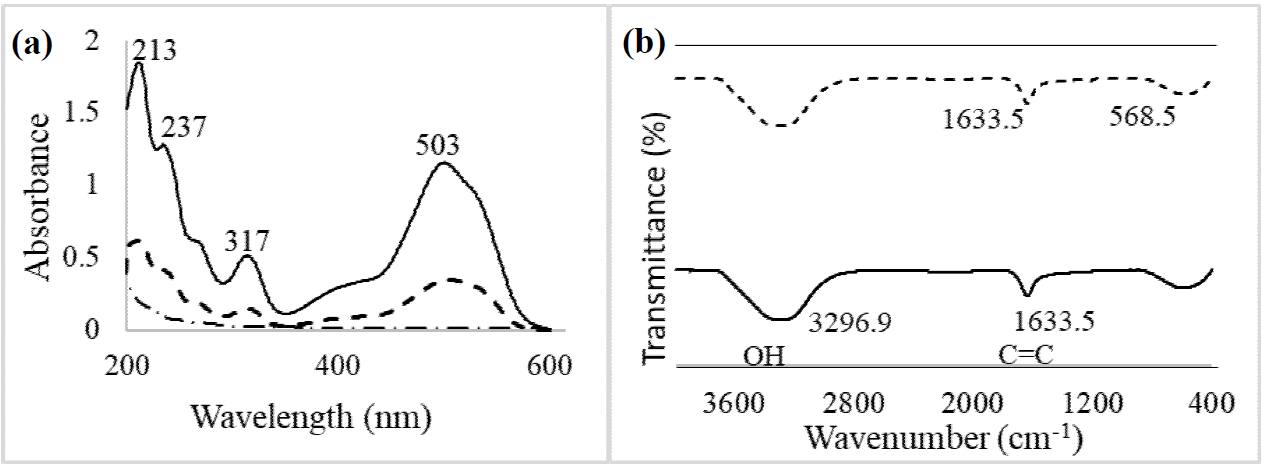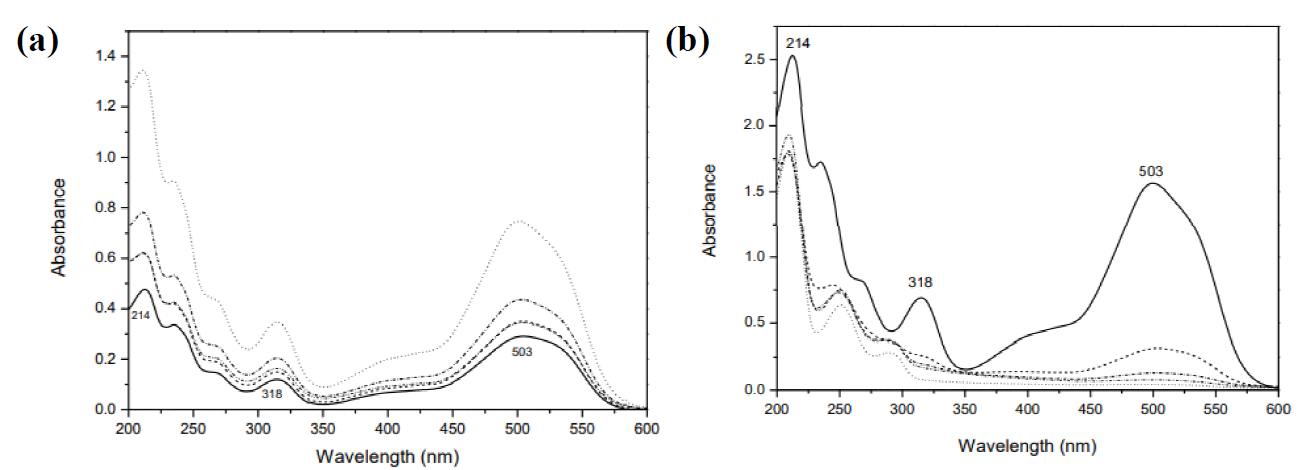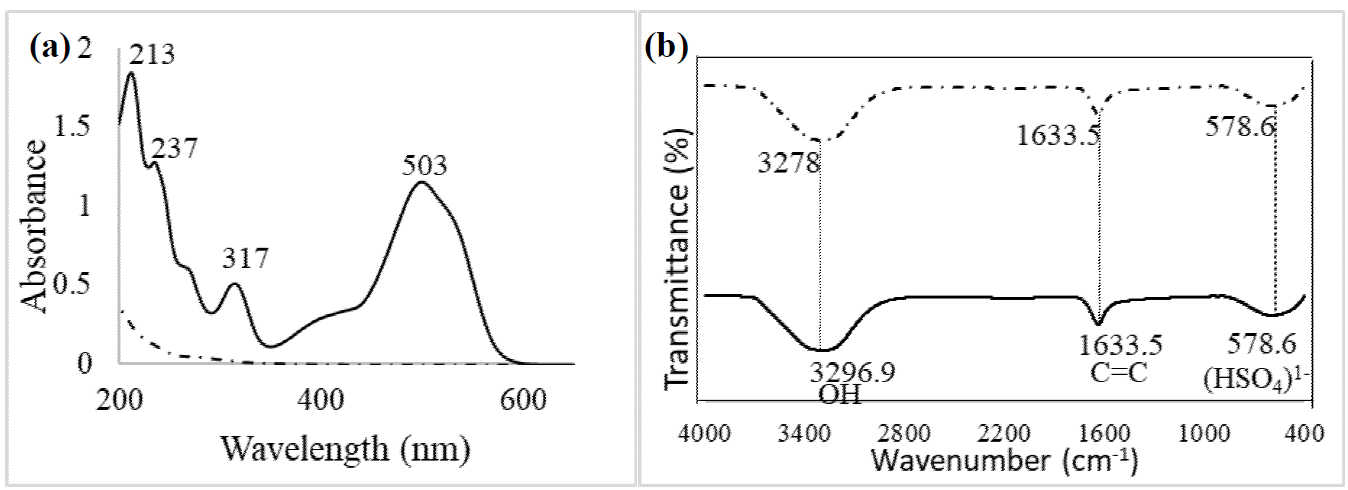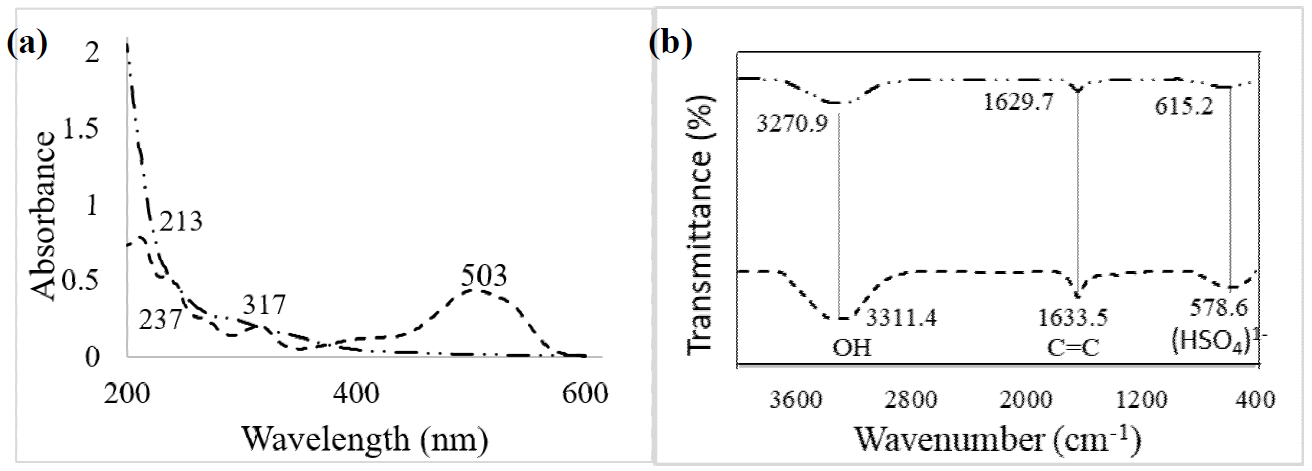Introduction
Synthetic dyes are widely used in many industrial processes such as the textile, pharmaceutical, food among others. However, in the textile industry, in particularly the fabric washing step, large quantities of residual wastewater are generated. When this wastewater is discharged without any treatment severe environmental impacts are caused. [1,2].
Dye natural degradation is a challenging task since there are made of large molecules with a complex structure which make them and some intermediates recalcitrant and resistant to biological processes; moreover, the presence of these compounds contribute to high levels of Biological Oxygen Demand (BOD5) and also Chemical Oxygen Demand (COD). Therefore, it is important to develop efficient wastewater treatment alternatives to provide affordable and secure services [3,4]
Advance oxidation processes rely in the high power and oxidation characteristic of the hydroxyl radical (•OH) to attack organic compounds. This radical has one of the highest oxidation potential of 2.80 V, capable of oxidize and in some cases mineralize organic molecules [5, 6]. In this way electrooxidation has been used for the degradation of chemical substances present in aqueous solutions [7]. The two main mechanisms that can be applied are the direct and indirect oxidation. Direct oxidation is performed in the electrode surface whereas the indirect oxidation requires that oxidation species are electrogenerated and then react in an aqueous solution [8,9].
One of the main and successful electrodes used for electrooxidation is the boron-doped diamond electrode (BDD) since it presents a high oxygen overpotential which produces a large amount of hydroxyl radical in the surface, oxygen evolution on BDD occurs with a high overpotential with respect to thermodynamic potential for oxygen formation (E° OER = 1.23 V vs. SHE), and is very close to the thermodynamic potential of •OH formation (E° OH = 2.38 V vs. SHE) [10 -12]. However, reaching a complete mineralization of organic molecules using these only techniques requires a high amount of energy and in many occasions, intermediate compound remains in aqueous solutions [13-15].
On the other hand, solar radiation is attracting the attention of many research groups since this energy source is unlimited, solar distillation is also gaining interest since a high water quality is produced without the addition of chemical reagents [16,17,18].
Solar radiation can synergize the photodegradation of dyes, since these substances are photosensitive and partially degrade when exposed to sunlight for a certain time, as demonstrated in a previous work where a modified solar heating and distillation system was coupled with a ZnO plate as a photocatalyst for the removal of the dye Carmine Red, achieving 93 % photodegradation at a time of 120 min of exposure [19].
Similarly, other studies on the photocatalytic activity of ZnO have been carried out, one of them employed ZnO nanostructures in the shape of sea urchins and needles in aqueous solutions of methylene blue dye under UV irradiation. The results show that both the crystallinity and the morphology of the prepared ZnO are very important for the photocatalytic activity, obtaining in this case a photodegradation greater than 98 % after 100 min of exposure [20]. Likewise, layers of TiO2 and ZnO have been deposited by means of screen printing on common ceramic tiles for the photocatalytic degradation of the organic dye Orange II in aqueous solutions, under direct exposure to sunlight. In this investigation, a percentage of photodegradation of 90 % was reported [21].
Thus, this paper presents the use of the solar distillation-photocatalyst process as the first synthetic water treatment and the electro-oxidation process as a polishing step for residual water. As a result, a low energy and environmentally friendly process provides a large amount of good quality treated water.
Experimental
Preparation of synthetic wastewater with Carmine Red dye
A solution of distilled water with Carmine Red dye was prepared at a concentration of 25 ppm. 6.25 mg of the dye were weighed using an analytical balance and added into a volumetric flask [19].
Parabolic solar concentrator
The parabolic solar concentrator is based on a parabolic surface that concentrates the radiation on a receiver and allows heating the water. The objective of this device was to preheat the wastewater in order to transfer it at a high temperature to the distiller still [22].
Single slope solar distiller construction
The device was designed with a single slope at 20° inclination degrees and was manufactured using anodized aluminum with a glass surface without optical distortion (to capture more solar radiation) [23].
Solar process
This process consists of two parts, in the first the residual water with dye is introduced into a parabolic solar heater where it is heated up to 80 °C degrees. The second stage consists of the evaporation and recovery of water in a solar still that contains a ZnO plate at the bottom which acts as a photocatalyst [19].
A schematic diagram is shown in Fig. 1.
Note, that there is a remaining aqueous solution that is not possible to evaporate and in which the dye and intermediate components are concentrated. This residual water is then submitted to electrooxidation as a polishing step to obtain a better water quality
Electrooxidation
This electrochemical treatment was applied at two different aqueous solutions for comparison purposes. The first one is the dye aqueous solution containing the concentration of 25 ppm. The second one is the residual water of the solar process. For both wastewaters, the same equipment was used. It consists of a 500 mL glass cylinder in which boron-doped diamond electrodes (BDD) and a stainless steel electrode, with a surface of 45 cm2, were introduced, then a volume of 400 mL of wastewater was added (see Fig. 2.). All the experiment were run at room temperature. In order to have a homogeneous solution a magnetic bar was collocated at the bottom of the glass cylinder. Both electrodes were connected to a direct current power source.
The effect of the pH of the aqueous solution was evaluated and two values were selected, 6.2 and 2.7 respectively. Another parameter that has influence in the electrooxidation process is the current density and two values were evaluated 22.2 and 16.6 mA cm-2 [24, 25].
To evaluate whether electrooxidation applied to residual water from the solar process requires low or high energy, energy consumption per volume (EC V ) was determined using the following equation:
where E cell is the potential difference of the cell (V), 𝐼𝐼 is the applied current (A), 𝑡𝑡is the total electrolysis time (h) and 𝑉 𝑠 is the solution volume (L) [26-27].
Determination of water quality parameters pH
The corresponding measurements were made using a Milwaukee m102 potentiometer with calibrations at 4.01 and 7.01 pH standard solutions [28].
Conductivity
Conductivity levels of all (initial and treated) aqueous solutions were detected using a Hanna conductivity meter model HI99301. For calibrating purposes, a standard pattern of 12.88 mS/cm was used [29].
COD
To obtain the COD, we proceeded according to the norm and the samples were read in a HACH DR/4000 U spectrophotometer [30]. This parameter was considered to compare both processes.
Turbidity
In order to obtain the turbidity value, the samples were shaken until homogeneous. Subsequently, each one was placed in a 1” square glass cell for 10 and 25 mL and they were read in a HACH DR/4000 U spectrophotometer [31].
UV-Vis spectrophotometry
Initial and treated water samples were analyzed in order to determine the absence of Carmine Red dye by means of a VELAB spectrophotometer, model VE-5100UV UV-Vis.
Results and discussion
Solar process results
A synthetic aqueous solution containing 25 ppm of Carmine Red was introduced in the solar process, which consist in a heating unit and then a solar distiller. When applying the solar process two different aqueous solutions are obtained. One is the distilled water which is a high-quality water and the amount obtained during the process is 165 mL, this represents 66 % of the original aqueous solution. The second kind of water is the residual wastewater, this water does not evaporated during the process and remains in the distiller deposit, the amount obtained is 85 mL or 33 % of the initial solution.
UV- Vis spectrum of the initial synthetic water, the distilled water and the residual water is presented in Fig. 3(a). Note that, the synthetic water has a peak in 503 nm with an absorbance of 1.1535, which is characteristic of Carmine Red, in the distilled water this peak in not present, and in the residual water appears but at a lower absorbance of 0.3457, obtaining a percentage of degradation of 70 %.

Fig. 3 (a) UV-Vis spectrophotometry: (─) initial synthetic wastewater at 25 ppm, (- -) photodegraded wastewater and (─ . ─) distilled water obtained with solar process. (b) IR-ATR spectrometry: (─) initial synthetic solution , (- -) solar treated water
In Fig. 3(b), the infrared spectrum shows the O- H bond coming from the water at 3296.9 cm -1, C=C at 1633.5 cm-1and the radical HSO4- at 578.6 cm-1 for the initial synthetic water. After the treatment there is a slight change for the O-H at 3311.4 cm-1 belonging to water, C=C stayed on the same wave number and the radical HSO4- to 568.5 cm-1.
As can be observed the residual water of the process requires a polishing treatment to attain a high quality, thus an electrooxidation process is applied. The results of this treatment are shown and discussed later.
Photocatalytic degradation of Carmine Red using a ZnO plate
Tarango et al. carried out a study of the use of a solar heating and distillation process to treat synthetic wastewater with Carmine Red dye. When the dye in aqueous solution was exposed to sunlight without using the ZnO photocatalyst was no degradation of the dye. This is confirmed in the UV-Vis spectra shown in Figure 4a.

Fig. 4 (a) UV-VIS spectrophotometry of water with Carmine Red dye, under treatment by a coupled solar heating distillation system (a) without galvanized plate and (b) modified with a galvanized plate with heat treatment. (─) H2O, (▬) initial 25 ppm, (- -) residue 11:30, (─·─) residue 12:00, (─··─) residue 12:30, (····) residue 13:00 [19].
Subsequently, ZnO plates were used as photocatalysts within the aqueous solution of the Carmine Red dye. As shown Fig, 4(b) there is a decrease in the absorbance of the characteristic peaks of the dye in the UV-Vis spectra as a function of treatment time reaching a dye degradation of 93 % [19].
In this sense, a ZnO photocatalyst plate was used in this project and the results are reported in Fig. 4(a), where a decrease in absorbance with respect to time can be observed. Thus, this photocatalyst help to increase the color removal in a 70 %.
Results comparison
ZnO has been used as a photocatalyst in some investigations. For example: Ballesteros et al. 2022, carried out a study of the use of ZnO nanostructures in an aqueous solution of methylene blue dye under UV irradiation. The results showed a degradation of 98 % in an exposure time of 100 min.
On the other hand, Rego et al. 2009, carried out an investigation on TiO2 layers deposited on ZnO for the degradation of the organic dye Orange II at a concentration of 20 mg/L in aqueous solution under exposure to sunlight and reported a percentage removal of 90 % and a rate of 2.9 × 10−3 min−1 decolorization.
Likewise, Tarango et al. 2022, ZnO plates were used as a photocatalyst adapted to a solar still to degrade the Carmine Red dye in aqueous solution under exposure to sunlight at a concentration of 25 ppm, reporting a dye degradation percentage of 93 % in a time of 120 min.
Also, Isa et al., 2015, adapted ZnO nanoparticles in microflower architecture for high degradation efficiency of Methyl Orange at a concentration of 10 mg L-1 under exposure to sunlight. They reported that a 99 % degradation was obtained in a time of 300 min.
In this work, a ZnO plate was improved for the degradation of the Allura Red dye, at a concentration of 25 ppm, where it was reported that when exposed to sunlight it undergoes a 70 % degradation in a time of 120 min, therefore which compared to some of the previous investigations was found to be below efficiency. For this reason, a polishing treatment was carried out using electrooxidation to improve dye degradation.
Electrooxidation results
Electrooxidation is an electrochemical method that allows to oxidize organic molecules achieving smaller molecules and in some cases mineralization.
Table 1 shows the results of applying two different current density values and using a pH of 6.2, whereas Table 2 shows the results when a pH of 2.7 is used.
Table 1 COD values at different process times using a pH of 6.2.
| Time / min | COD mg/L Current density 22.2 mA cm-2 | COD mg/L Current density 16.6 mA cm-2 |
|---|---|---|
| 0 | 37 | 37 |
| 15 | 14.4 | 19.2 |
| 30 | 9.8 | 15.2 |
| 45 | 6.2 | 11.5 |
| 60 | <1 | 8.1 |
| 75 | <1 | <1 |
Table 2 COD values at different process time using a pH of 2.7.
| Time / min | COD 22.2 mA cm-2 / mg/L | COD 16.6 mA cm-2 / mg/L |
|---|---|---|
| 0 | 37 | 37 |
| 15 | 11.8 | 15.7 |
| 30 | 3.5 | 11.5 |
| 45 | <1 | 9.0 |
| 60 | <1 | 4.3 |
| 75 | <1 | <1 |
As can be observed from Table 1 and Table 2, in all cases the electrooxidation process is effective in reducing the concentration of COD. However, this process takes more time when the pH is 6.2 and using a low current density value. On the other hand, the process is accelerated when a low pH is used, and a high current density is applied. In previous reports authors have noted that pollutant removal increases when the pH is changed to acidic conditions, better results are observed when changing pH from 6.2 to 3. This phenomenon is due to the formation of ·OH radicals on the surface of the BDD electrode which are favored in an acidic environment [33].
The chemical oxygen demand was selected as the physicochemical parameter to evaluate the process, samples of the initial solution were taken at elapsed times of 15 min until a 75 min treatment was performed. The effect of the current density in the process was tested and two values of this parameter were tried, 22.2 and 16.6 mA cm-2, after 45 min with a pH of 6.2 the COD removal efficiency was 83 % and 69 %. Therefore, as the current density increases, the COD removal efficiency increases. These results agree with the ones reported by Y. Tang et, which mention that increasing the current density quickens the rate of electron transfer and consequently the rate of direct oxidation of contaminants is accelerated, that is, color removal increases Also, two different aqueous solution pH values were used, namely 6.2 and 2.7. The effect is that after 30 min, the COD removal efficiency using a current density of 22.2 mA cm-2 was 75 % and 91 % respectively under acid conditions. [34].
In 2015, Thiam et al. studied the decolourization and mineralization of solutions of the azo dye Allura Red AC at pH 3.0 in sulfate medium by electrochemical oxidation with electrogenerated H2O2 (electrooxidation-H2O2), electro-Fenton (EF) and photoelectro -Fenton (PEF), with a stirred tank reactor containing a boron-doped diamond (BDD) or Pt anode and an air-diffusion cathode to generate H2O2. The results shows that the PEF-BDD was the most efficient, the TOC reduction reached was 96-98 % at 360 min, at a j value of 33.3 mA cm-2 [35].
Dos Santos et al. evaluate the use of Pt and BDD anodes in the electrochemical degradation of Ponceau SS diazo dye solution in an acidic sulfate medium. A total organic carbon removal of 93. 8 % was reached with a photoelectro-Fenton process using a BDD anode at j ≥ 50 mA cm-2 in 180 min [36].
GilPavas et al. evaluated the mineralization of Tartrazine by electrooxidation using BDD and Ti electrodes in a monopolar configuration. The greatest degradation was improved at a pH of 6 and a j=10 mA cm-2, with a COD reduction of 77.5 % in 15 min. Additionally, they evaluated the photoelectro-Fenton process, obtaining efficiency in COD degradation of 93 % in 30 min [37]. The results of these investigations are consistent with the data obtained for the present work, in relation to the mineralization of organic matter expressed as the reduction of its concentration in terms of COD.
Fig. 5(a) shows the UV-Vis spectrum of the initial aqueous solution and the spectrum of the electrochemically treated water under the best process conditions. It is interesting to note that the characteristic peak of Carmine Red is at 503 nm, but when the process is applied, the treated water does not have it. In the case of IR (Fig. 5(b)) it showed a behavior similar to that shown in Fig. 5(b).

Fig. 5 (a) UV-Vis spectra of the (─) initial synthetic wastewater at 25 ppm (─·─)treated with electro-oxidation (b) IR-ATR spectrum (─) initial synthetic water (─·─) electrooxidation treatment
The results indicates that the electrochemical process is a good option for treating aqueous solution containing a dye. Therefore, the electrooxidation process at the best conditions are applied at the residue water obtained during the solar process and the results are presented in the next section.
Electrochemical process applied to the residual water of the solar process
Residual water of the solar process was introduced into the electrochemical reactor. The pH of the aqueous solution was adjusted to 2.7 and the current density applied was set at 22.2 mA cm-2
Table 3 shows the COD values as a function of process time. It can be observed that, the COD values (decreases very rapidly, it takes 40 minutes to have a low value of the COD. Energy consumption per volume ) considering the mentioned conditions was 5 kW h L-1, the estimated cost of this consumption was 0.355 US$ L-1, assuming an average retail price of electricity for the industrial sector of US$ 0.071 per kW h (Comisión Federal de Electricidad).
Electrooxidation with BDD electrodes has the advantage of consuming less energy compared to other systems due to its high electrical conductivity and charge transfer efficiency [26, 27,37]. Titchou F.E. et al. carry out a comparative study for the degradation of the Direct Red 23 dye using different anodes: carbon graphite (CG), dimensionally stable anode (DSA), Magnéli phase Ti4O7, and boron-doped diamond (BDD). They calculated the energy consumption (kWh g−1 TOC) for each system and the BDD anodes had the lowest energy consumption per g of TOC removed (2.05 and 2.6 kWh g−1 TOC), that is, the energy consumption was given in the following order BDD < Ti4O7 < CG < DSA [26].
Table 2 and Table 3 shows COD values obtained in the electrooxidation and solar-electrooxidation processes and the information can be used for comparison purposes. The solar process produces a high quality water since all the values are low in the distilled water, however, only 66 % of this water is obtained. The electrochemical process used in the initial aqueous solution requires to use a low pH value and 30 minutes of treatment to achieve good water quality. However, when the electrochemical process is applied at the residual water of the solar process it takes 5 minutes to achieve satisfactory levels. These results are very encouraging since low energy is required to have an overall good water when the solar process and electrooxidation are coupled, there are encouraging results since lower energy is required to obtain good water quality.
Fig. 6(a) shows the UV-Vis spectrum of wastewater from the solar process and the spectrum of water treated by solar process and later electrochemically treated. It is clear the presence of the characteristic Carmine Red peak occurs only in the initial solution, which was submitted to the solar process.

Fig. 6 (a) UV-Vis spectrophotometry of photodegraded wastewater: (─)solar process; (---) solar process and electro-oxidation y (b) IR-ATR: (---) solar process, (─··─) solar and electrooxidation combined.
According to the UV-Vis spectra, the initial water has an absorbance value of 1.1535 which, when treated solely by the solar process with the ZnO plate, decreases to 0.3457 with a degradation percentage of 70 % at 120 min of exposure to sunlight. When comparing this data with the investigations of Ballesteros et al., Rego et al. and Tarango et al., who report degradation percentages of different dyes of 98 % in a time of 100 min, 90 % (without time report) and 93 % in 120 min respectively, it is observed that the value obtained in the present work is lower than those reported by the authors, this is why the polishing process with electro-oxidation is very convenient, since the peak of the dye in the UV spectrum disappears (Fig. 6(a)).
In the case of the IR spectra (Fig. 6(b)), there is a displacement of the O-H bond coming from water at 3270.9 cm-1 and from C=C at 1629.7 cm-1 and (HSO4)1- at 615.2 cm-1.
The results of conductivity and turbidity obtained for the different samples of water treated by the solar process, electrooxidation and electrochemistry applied to residual water from the solar process are shown below. According to Table 4, the conductivity values increase for the treated water samples with respect to the value for the initial synthetic wastewater, due to the possible presence of ions from the degradation process.
Tabla 4 Conductivity and turbidity of water samples.
| Treatment | Conductivity [mS/cm] | Turbidity [UNT] |
| Initial water (synthetic residual with dye at 25 ppm) | 0.03 | 0 |
| Solar process | 0.56 | 33 |
| solar process and electrooxidation | 0.87 | 0 |
| electrooxidation | 0.86 | 0 |
On the other hand, turbidity does not demonstrate the presence of suspended solids, however in the solar process they are formed by the presence of ZnO.
Conclusions
The use of a solar system produces a high quality water since a phase separation takes place and the recovered water is pollutant free; however, a concentrate aqueous solution remains. This residue needs further treatment to achieve good quality.
When an electrochemical process is applied to an aqueous solution containing Carmine Red dye, a reduction in COD and colour values can be achieved. The best conditions occur at acidic pH and a current density of 22.2 mA cm-2.
The use of an electrochemical process for the treatment of a residual water from a solar process is effective in reducing COD and color characteristics producing a better water quality. The use of the combined system produces clean water using low energy.











 nueva página del texto (beta)
nueva página del texto (beta)




